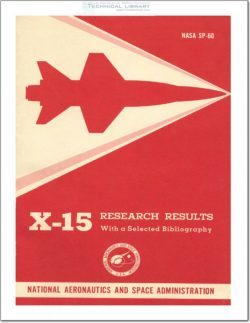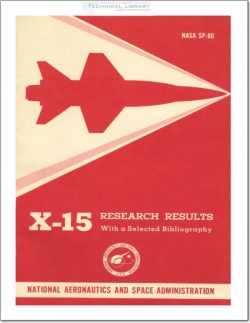NASA-SP-60

- Version
- 200 Downloads
- 2.82 MB File Size
- 1 File Count
- August 18, 2016 Create Date
- August 18, 2016 Last Updated
Research Results with a Selected Bibliography

In a period of a little more than sixty years since the first
flight of the Wright Brothers, man’s exploration of three-dimen-
sional space above the surface of the Earth has extended beyond the
atmosphere. Spectacular and exciting events in this dramatic quest
have been well publicized. Behind these milestones of practical
flight have been less publicized achievements in scientific research,
making such progress possible. Although the X—15 has had its share
of newsworthy milestones, its contributions to scientific research have
been a more essential and more meaningful part of the program from
its inception. This semi-technical summary of the X—15 program
is directed toward the less publicized aspects of its achievements.
The year 1964 marks the tenth anniversary of the inception of
the X—15 flight-research program, the fifth year since the first X—15
flight. When the program was first approved, its objectives were
clearly stated in terms of aerodynamic heating, speed, altitude, sta-
bility-and-control research, and bioastronautics. Although these
objectives have been essentially accomplished, it now appears that
the three X—lS’s may be flown for perhaps another five years, in a
new role as test beds for fresh experiments utilizing the X—15 per-
formance, which still offers more than twice the speed and three times
the altitude capability of any other aircraft now in existence.
Even though the program has been most successful in terms of
achieving its planned objectives and is continuing to play an impor-
tant role in aerospace research, many notable benefits have been of
a different nature—more intangible and somewhat unforeseen at
the time the X—15 program was approved. In the early years of our
nation’s space program, which has been based to a large extent on
the unmanned-missile technology that had been developed over the
five years prior to Project Mercury, the X—15 has kept in proper
perspective the role of the pilot in future manned space programs.
It has pointed the way to simplified operational concepts that should
provide a high degree of redundancy and increased chance of suc-
cess in these future missions. All of the people in industry and in
government who have had to face the problems of design and of
building the hardware and making it work have gained experience
of great value to the more recent programs now reaching flight
phase and to future aeronautical and space endeavors of this country.
| File | Action |
|---|---|
| NASA-SP-60 X-15 Research Results with a Selected Bibliography.pdf | Download |
Comment On This Post